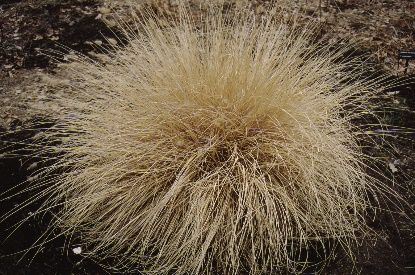Introduction
'Hameln' is a dwarf cultivar of fountain grass reportedly unsuited for the deep South that often reaches 2 to 3 feet tall. The white inflorescence resembles a bottle brush and persists into fall. These attractive, 5 to 7 inch long flowers persist on the plant from summer to fall but shatter in the early winter. The foliage of fountain grass is bright green during the summer but turns to a golden brown color in the fall after the flowers begin to die. The foliage arches near the tip and gives the plant a graceful fountain shape. Fountain grass is an outstanding, elegant, fine-textured ornamental grass. Unlike the species, this cultivar does not re-seed itself.

Credit: Edward F. Gilman, UF/IFAS

Credit: Edward F. Gilman, UF/IFAS

Credit: Edward F. Gilman, UF/IFAS
General Information
Scientific name: Pennisetum alopecuroides 'Hameln'
Pronunciation: pen-niss-SEE-tum al-loe-peck-yer-ROY-deez
Common name(s): dwarf fountain grass, 'Hameln' fountain grass
Family: Poaceae
Plant type: ornamental grass; herbaceous
USDA hardiness zones: 5 through 8 (Figure 4)
Planting month for zone 7: year-round
Planting month for zone 8: year-round
Origin: not native to North America
Invasive potential: not known to be invasive
Uses: mass planting; container or above-ground planter; accent; border; cut flowers
Availability: somewhat available, may have to go out of the region to find the plant

Credit:
Description
Height: 2 to 3 feet
Spread: 2 to 3 feet
Plant habit: upright
Plant density: moderate
Growth rate: fast
Texture: fine
Foliage
Leaf arrangement: most emerge from the soil, usually without a stem
Leaf type: simple
Leaf margin: entire
Leaf shape: linear
Leaf venation: parallel
Leaf type and persistence: deciduous
Leaf blade length: 18 to 36 inches
Leaf color: green
Fall color: brown or tan
Fall characteristic: showy
Flower
Flower color: white
Flower characteristic: summer flowering; fall flowering
Fruit
Fruit shape: unknown
Fruit length: unknown
Fruit cover: unknown
Fruit color: unknown
Fruit characteristic: inconspicuous and not showy
Trunk and Branches
Trunk/bark/branches: typically multi-trunked or clumping stems
Current year stem/twig color: not applicable
Current year stem/twig thickness: not applicable
Culture
Light requirement: plant grows in full sun
Soil tolerances: acidic; slightly alkaline; sand; loam; clay
Drought tolerance: high
Soil salt tolerances: unknown
Plant spacing: 36 to 60 inches
Other
Roots: not applicable
Winter interest: plant has winter interest due to unusual form, nice persistent fruits, showy winter trunk, or winter flowers
Outstanding plant: plant has outstanding ornamental features and could be planted more
Pest resistance: long-term health usually not affected by pests
Use and Management
This graceful plant has a beautiful effect when its image is reflected in water. It is usually massed together in a landscape bed or planted alone or in a small grouping in a perennial border to provide fine texture. It is suited for the residential landscape more than most other ornamental grasses because of its small size. It can "make" a landscape with its extremely fine texture that provides a cooling effect as it blows in even the slightest breeze. Fountain grass makes an effective, tall ground cover plant or single specimen plant.
Fountain grass needs to be planted in a site that receives full sun and has well-drained soils. Be prepared to provide some irrigation during dry weather in the summer. The center of the plant becomes open as the plant ages with most of the stems originating along the margin of an open ring. Divide the open clump and re-plant to rejuvenate it.
The propagation of this grass is by division every 5 to 10 years.
Pests and Diseases
No pests or diseases are of major concern.